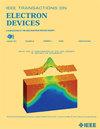A SPICE Model of Electrolyte Synaptic Transistors
IF 3.2
2区 工程技术
Q2 ENGINEERING, ELECTRICAL & ELECTRONIC
引用次数: 0
Abstract
In recent years, electrolyte synaptic transistors have become a popular choice for neuromorphic computing hardware due to their low power consumption, high linearity, and dynamic conductance modulation capabilities. However, the lack of precise circuit models of electrolyte synaptic transistors limits the convenience of exploring electrolyte transistors-based circuits or systems. In this study, we propose a universal model for electrolyte synaptic transistors by decoupling ionic and electronic transport process. The model is highly flexible and adaptable to various electrolyte synaptic transistor devices, allowing for easy modulation of synaptic characteristics through parameter adjustments. Inspired by the adaptive capabilities of biological sensory systems, we constructed a simplified circuit based on the proposed model and validated it through LTSPICE simulations. The results demonstrate that the model accurately captures the pulse modulation capabilities of electrolyte synaptic transistors and effectively simulates the response characteristics of biological sensory neurons. The proposed electrolyte synaptic transistor model would facilitate the convenience of exploring electrolyte transistors-based circuits or systems.电解质突触晶体管的SPICE模型
近年来,电解质突触晶体管因其低功耗、高线性度和动态电导调制能力而成为神经形态计算硬件的热门选择。然而,缺乏精确的电解质突触晶体管电路模型限制了探索基于电解质晶体管的电路或系统的便利性。在本研究中,我们通过离子和电子输运过程的解耦,提出了电解质突触晶体管的通用模型。该模型高度灵活,适用于各种电解质突触晶体管器件,允许通过参数调整轻松调制突触特性。受生物感觉系统自适应能力的启发,我们基于所提出的模型构建了一个简化电路,并通过LTSPICE仿真对其进行了验证。结果表明,该模型准确地捕捉了电解质突触晶体管的脉冲调制能力,有效地模拟了生物感觉神经元的响应特性。提出的电解质突触晶体管模型将有助于探索基于电解质晶体管的电路或系统。
本文章由计算机程序翻译,如有差异,请以英文原文为准。
求助全文
约1分钟内获得全文
求助全文
来源期刊

IEEE Transactions on Electron Devices
工程技术-工程:电子与电气
CiteScore
5.80
自引率
16.10%
发文量
937
审稿时长
3.8 months
期刊介绍:
IEEE Transactions on Electron Devices publishes original and significant contributions relating to the theory, modeling, design, performance and reliability of electron and ion integrated circuit devices and interconnects, involving insulators, metals, organic materials, micro-plasmas, semiconductors, quantum-effect structures, vacuum devices, and emerging materials with applications in bioelectronics, biomedical electronics, computation, communications, displays, microelectromechanics, imaging, micro-actuators, nanoelectronics, optoelectronics, photovoltaics, power ICs and micro-sensors. Tutorial and review papers on these subjects are also published and occasional special issues appear to present a collection of papers which treat particular areas in more depth and breadth.
 求助内容:
求助内容: 应助结果提醒方式:
应助结果提醒方式:


